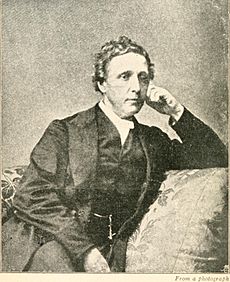Lewis Carroll facts for kids
Quick facts for kids
Lewis Carroll
|
|
|---|---|

Carroll in June 1857
|
|
| Born | Charles Lutwidge Dodgson 27 January 1832 Daresbury, Cheshire, England |
| Died | 14 January 1898 (aged 65) Guildford, Surrey, England |
| Resting place | Mount Cemetery, Guildford, Surrey, England |
| Occupation |
|
| Education | |
| Genre |
|
| Parents | Charles Dodgson (father) |
| Relatives |
|
| Signature | |
Charles Lutwidge Dodgson (born January 27, 1832 – died January 14, 1898) was an English author, poet, and mathematician. He is much better known by his pen name Lewis Carroll. His most famous books are Alice's Adventures in Wonderland (1865) and its follow-up, Through the Looking-Glass (1871). He was very good at using word play, logic, and fantasy in his writing. His poems Jabberwocky (1871) and The Hunting of the Snark (1876) are examples of "literary nonsense".
Carroll came from a family with strong religious beliefs. He spent most of his life at Christ Church, Oxford, where he was a scholar and teacher. Many people believe that Alice Liddell, the daughter of the head of Christ Church, was the inspiration for Alice in Wonderland. However, Carroll always said this was not true.
He loved puzzles and even created the word ladder puzzle, which he called "Doublets." He published these puzzles in a magazine called Vanity Fair between 1879 and 1881. In 1982, a special stone was placed for Carroll in Poets' Corner at Westminster Abbey. There are groups all over the world that enjoy and promote his amazing works.
Contents
Early Life and Education
Dodgson's family was mostly from northern England. They were conservative and had strong religious beliefs. Many of his male ancestors were army officers or church leaders. His great-grandfather, Charles Dodgson, became a bishop in Ireland. His grandfather, also named Charles, was an army captain.
Carroll's father, another Charles Dodgson, went to Westminster School and Christ Church, Oxford. He was very good at math and became a country parson after marrying Frances Jane Lutwidge.
Childhood and Family
Charles Lutwidge Dodgson was born on January 27, 1832, in Daresbury, Cheshire. He was the oldest boy and the third oldest of 11 children. When he was 11, his family moved to a large rectory in Croft-on-Tees, Yorkshire. This remained their home for 25 years.
Charles's father was a very active and traditional church leader. He tried to teach his children his religious views. Charles, however, had mixed feelings about his father's beliefs and the church.
School Days
Dodgson was taught at home when he was young. His reading lists show he was very smart from an early age. By seven, he was reading books like The Pilgrim's Progress. He also had a stammer, which made social situations difficult for him.
At age 12, he went to Richmond Grammar School. In 1846, Dodgson started at Rugby School. He was not happy there, saying he would never want to go through those three years again. He felt that younger boys were often picked on by older bullies. However, his nephew wrote that Charles was known for standing up for smaller boys.
Despite his unhappiness, he was an excellent student. His math teacher said he had not seen a more promising boy his age. He even wrote "Not a fair question in decimals" next to a math problem in his textbook!
University Years
Dodgson left Rugby in 1849 and started at the University of Oxford in May 1850. He joined his father's old college, Christ Church. Just two days after moving in, his mother died at age 47.
His early time at Oxford was a mix of great promise and distractions. He was very talented, and success came easily to him. In 1852, he earned top honors in math. In 1854, he again received top honors in math and graduated with a Bachelor of Arts degree. He stayed at Christ Church, studying and teaching. In 1855, his math skills earned him the Christ Church Mathematical Lectureship. He held this teaching job for 26 years. Dodgson stayed at Christ Church until he died.
Personality and Appearance
Health and Speech
As a young adult, Charles Dodgson was about 6 feet 2 inches tall and thin. He had curly brown hair and blue or grey eyes. Later in life, he was described as a bit stiff and awkward, possibly due to a knee injury. When he was very young, a fever left him deaf in one ear. At 17, he had a bad case of whooping cough, which may have caused his weak chest later on.
He developed a stammer as a child, which he called his "hesitation." It stayed with him his whole life. Some people thought he only stammered around adults, but there is no proof of this. Many children remembered his stammer, while some adults did not notice it. Dodgson himself seemed more bothered by it than others. He supposedly made fun of himself as the Dodo in Alice's Adventures in Wonderland, referring to his difficulty saying his last name. However, this is just a guess.
Even though his stammer bothered him, it did not stop him from doing well in society. He was a good entertainer, able to sing, mimic voices, tell stories, and play charades.
Friends and Connections
Before his Alice books became famous, Dodgson became friends with artists from the Pre-Raphaelite group. He met John Ruskin in 1857 and became close with Dante Gabriel Rossetti and his family around 1863. He often took photos of the Rossetti family. He also knew other artists like William Holman Hunt and John Everett Millais.
He was good friends with the fairy-tale author George MacDonald. It was the excitement of MacDonald's children about his Alice story that encouraged Dodgson to publish it.
Beliefs and Ideas
Dodgson was generally seen as traditional in his politics and religion. He was ordained as a deacon in the Church of England in 1861. His diary shows he was very religious and prayed often. He also wrote that he was a member of the Church of England but wasn't sure if he was a "High Churchman."
He was also interested in other areas, like the Society for Psychical Research, which studied things like "thought reading." Dodgson also wrote about different philosophical ideas. In 1895, he wrote an article called "What the Tortoise Said to Achilles" about how we reason.
Creative Pursuits
Writing and Stories
From a young age, Dodgson loved writing poetry and short stories. He wrote a lot for his family's magazine, Mischmasch. Later, he sent his work to other magazines and had some success. Between 1854 and 1856, his writings appeared in national publications like The Comic Times. Most of his early work was funny. He was very ambitious, writing in 1855 that he hoped to write something truly worthy of publication someday.
In March 1856, he published his first work under the name "Lewis Carroll." It was a poem called "Solitude." This pen name was a clever play on his real name, Charles Lutwidge Dodgson. "Lewis" came from "Ludovicus," the Latin for Lutwidge. "Carroll" came from "Carolus," the Latin for Charles. So, Charles Lutwidge became Carolus Ludovicus, then Carroll Lewis, and finally Lewis Carroll.
The Alice Books
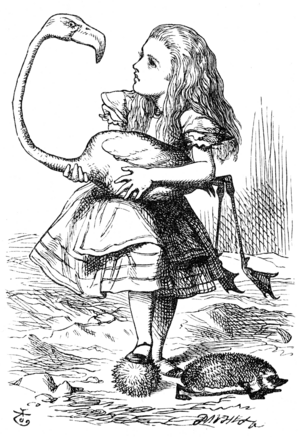
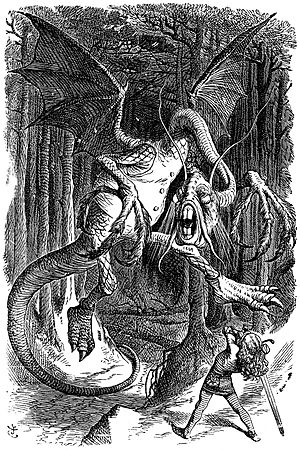
In 1856, Dean Henry Liddell moved to Christ Church with his young family. They became very important in Dodgson's life and writing. Dodgson became close friends with Mrs. Liddell and their children, especially the three sisters Lorina, Edith, and Alice Liddell.
He often took the children on rowing trips to nearby places like Nuneham Courtenay. It was on one of these trips, on July 4, 1862, that Dodgson made up the story that became his first big success. Alice Liddell loved the story and asked him to write it down. After some time, Dodgson gave her a handwritten, illustrated book called Alice's Adventures Under Ground in November 1864.
Before this, the children of his friend George MacDonald read the unfinished story. Their excitement encouraged Dodgson to try to publish it. In 1863, he showed the story to the publisher Macmillan, who liked it right away. After thinking about other titles, the book was finally published as Alice's Adventures in Wonderland in 1865. He used his pen name, Lewis Carroll. The famous illustrations were done by John Tenniel.
The huge success of Alice's Adventures in Wonderland changed Dodgson's life. His pen name, "Lewis Carroll," became famous worldwide. He received lots of fan mail and attention. He also started earning a lot of money but continued his teaching job at Christ Church.
In late 1871, he published the sequel, Through the Looking-Glass, and What Alice Found There. This book has a slightly darker mood, which might reflect changes in Dodgson's life. His father's death in 1868 had made him feel sad for several years.
The Hunting of the Snark
In 1876, Dodgson wrote his next major work, The Hunting of the Snark. This was a fantastic "nonsense" poem, with drawings by Henry Holiday. It tells the story of a strange crew of nine tradesmen and a beaver who go looking for the Snark. The poem was very popular with the public and was reprinted many times.
Sylvie and Bruno
In 1895, 30 years after his famous Alice books, Carroll tried to write another big story. He created a two-volume tale about fairy siblings called Sylvie and Bruno. The story mixes two worlds: one in rural England and another in magical fairy kingdoms. The fairy world makes fun of English society and university life. Sylvie and Bruno is not as well-known as his Alice books, but it has remained in print for over a century.
Photography (1856–1880)
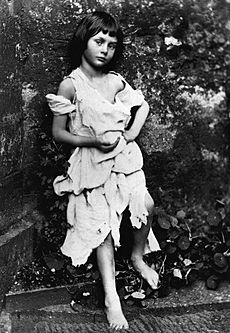
In 1856, Dodgson started learning photography. He quickly became very good at it and was known as a skilled gentleman-photographer. He even thought about becoming a professional photographer at one point.
More than half of his surviving photos show young girls. However, he also took many pictures of men, women, boys, landscapes, skeletons, dolls, and animals. His photos of children were always taken with a parent present. Many pictures were taken in the Liddell garden because natural sunlight was important for good photos back then.
Photography also helped him meet important people. He took portraits of famous figures like John Everett Millais, Ellen Terry, Dante Gabriel Rossetti, and Alfred Tennyson.
Dodgson stopped taking photos suddenly in 1880, after 24 years. He had created about 3,000 images, but fewer than 1,000 have survived. He stopped because keeping his studio running took too much time. Also, new photography methods made it easier and faster for others to take pictures.
Inventions and Puzzles
Dodgson was also an inventor! To encourage letter writing, he created "The Wonderland Postage-Stamp Case" in 1889. This was a cloth folder with slots for different stamps. It came in a decorated case with pictures of Alice and the Cheshire Cat.
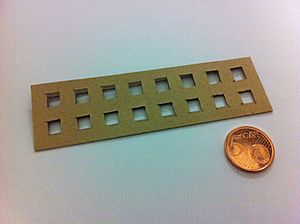
Another invention was a writing tablet called the nyctograph. This allowed him to take notes in the dark, so he didn't have to get out of bed to turn on a light when he had an idea. It had a grid and special symbols for letters.
He also invented several games. Around 1878, he created the "doublet," which is now known as a word ladder. This puzzle involves changing one word into another by changing only one letter at a time, making sure each new word is real. For example, to change CAT to DOG: CAT, COT, DOT, DOG. He wrote a weekly column for Vanity Fair magazine for two years, featuring these puzzles.
Other inventions included a way to find the day of the week for any date, a method for making typewriter margins even, and fairer rules for tennis tournaments. He even designed a special cardboard scale for Christ Church to make sure people got the right amount of liqueur for their money! He also created at least two ciphers for secret messages.
He also suggested different ways for people to vote in elections. He proposed a system called Dodgson's method and another system for fair representation in parliament.
Mathematical Work
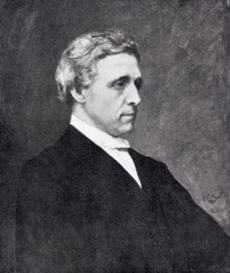
As a mathematician, Dodgson mainly worked on geometry, linear algebra, mathematical logic, and recreational mathematics. He wrote almost a dozen books under his real name. He also came up with new ideas in probability and the study of elections. His job as a Mathematical Lecturer at Christ Church gave him financial security.
Logic and Algebra
His work in mathematical logic became very interesting to people again in the late 1900s. It is now known that in his book Symbolic Logic Part II, Dodgson introduced the Method of Trees, which was an early version of a modern truth tree.
He also developed a method for solving math problems called Dodgson condensation. This method helps in evaluating determinants, which are special numbers used in algebra.
Fun Math Problems
In the 1990s, more of Dodgson's secret codes were found. These showed that he used very complex math ideas to create them. He also had a system called "Memoria Technica" to help remember things.
Letters and Correspondence
Dodgson was a very active letter writer. He kept a special register and wrote and received nearly 98,721 letters! He even wrote a pamphlet called "Eight or Nine Wise Words about Letter-Writing" to give advice on how to write better letters.
Later Years and Passing
Dodgson's life did not change much in his last twenty years, even though he became wealthy and famous. He continued teaching at Christ Church until 1881 and lived there until he died. He even went to see the musical Alice in Wonderland in London in 1886. His last novel, Sylvie and Bruno, was published in two parts in 1889 and 1893. However, it was not as popular as his Alice books.
The only time he traveled outside England was a trip to Russia in 1867 with a friend. He wrote about this journey in his "Russian Journal." On his way, he also visited cities in Belgium, Germany, Poland, and France.
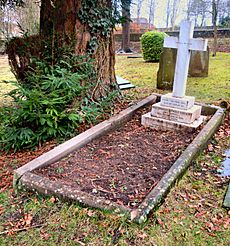
Charles Dodgson died of pneumonia after getting influenza on January 14, 1898. He passed away at his sisters' home in Guildford, Surrey. He was just two weeks shy of his 66th birthday. His funeral was held at the nearby St Mary's Church. He was buried at the Mount Cemetery in Guildford.
He is remembered at All Saints' Church, Daresbury, where stained glass windows show characters from Alice's Adventures in Wonderland.
Legacy and Remembrance
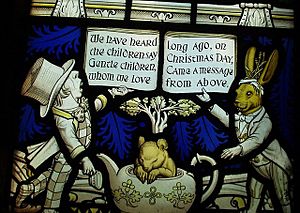
There are groups around the world dedicated to enjoying his works and learning about his life.
In north London, there is a Lewis Carroll Children's Library on Copenhagen Street.
In 1982, a special memorial stone for him was placed in Poets' Corner at Westminster Abbey. In January 1994, an asteroid was discovered and named 6984 Lewiscarroll after him. The Lewis Carroll Centenary Wood, near his birthplace in Daresbury, opened in 2000.
Lewis Carroll is honored at All Saints' Church, Daresbury, where he was born. The church has stained glass windows showing characters from Alice's Adventures in Wonderland. In March 2012, the Lewis Carroll Centre, connected to the church, was opened.
Works by Lewis Carroll
Famous Stories and Poems
- La Guida di Bragia, a Ballad Opera for the Marionette Theatre (around 1850)
- "Miss Jones", comic song (1862)
- Alice's Adventures in Wonderland (1865)
- Phantasmagoria and Other Poems (1869)
- Through the Looking-Glass, and What Alice Found There (includes "Jabberwocky" and "The Walrus and the Carpenter") (1871)
- The Hunting of the Snark (1876)
- Rhyme? And Reason? (1883)
- A Tangled Tale (1885)
- Sylvie and Bruno (1889)
- The Nursery "Alice" (1890)
- Sylvie and Bruno Concluded (1893)
- Pillow Problems (1893)
- What the Tortoise Said to Achilles (1895)
- Three Sunsets and Other Poems (1898)
- The Manlet (1903)
Math Books
- A Syllabus of Plane Algebraic Geometry (1860)
- The Fifth Book of Euclid Treated Algebraically (1858 and 1868)
- An Elementary Treatise on Determinants, With Their Application to Simultaneous Linear Equations and Algebraic Equations
- Euclid and his Modern Rivals (1879)
- Symbolic Logic Part I
- Symbolic Logic Part II (published after his death)
- The Alphabet Cipher (1868)
- The Game of Logic (1887)
- Curiosa Mathematica I (1888)
- Curiosa Mathematica II (1892)
- The Theory of Committees and Elections (collected and published in 1958)
Other Writings
- Some Popular Fallacies about Vivisection
- Eight or Nine Wise Words About Letter-Writing
- Notes by an Oxford Chiel
- The Principles of Parliamentary Representation (1884)
Images for kids
See also
 In Spanish: Lewis Carroll para niños
In Spanish: Lewis Carroll para niños
- Lewis Carroll identity
- Lewis Carroll Shelf Award
- RGS Worcester and The Alice Ottley School
- Carroll diagram
- Origins of a Story
- The White Knight


